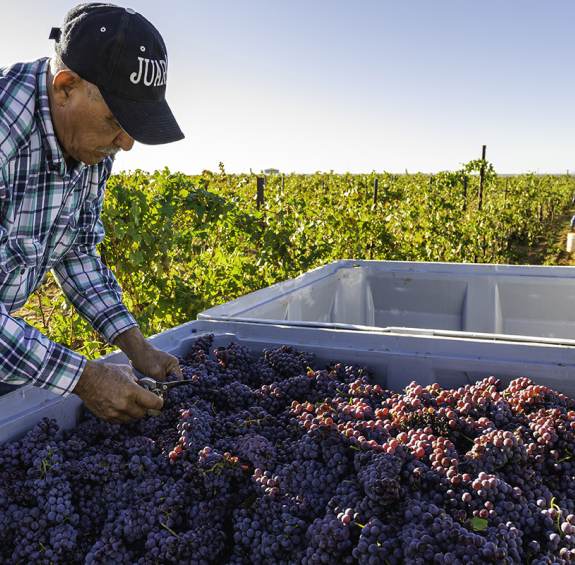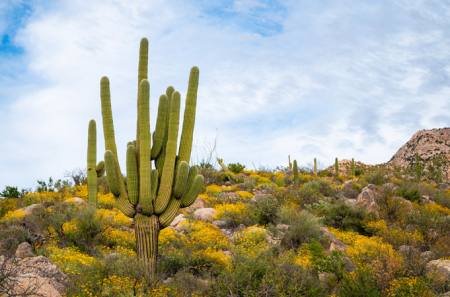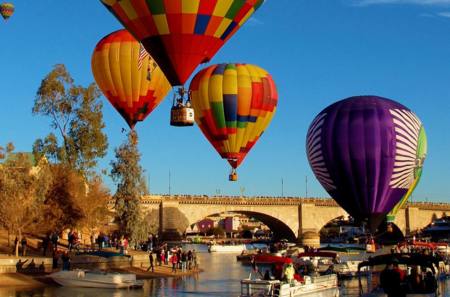To borrow an all-too familiar metaphor, Arizona’s burgeoning wine industry is the wild west of modern winemaking. The hardscrabble band of vintners cultivating Italian and French varietals in a climate plagued by blistering sunshine and drenching monsoons are true pioneers — pioneers who know a good thing when they see it. Where others see arid scrubland, they see the ideal loamy soil. Where some might be thrown by the wild swings in temperature from dawn to dusk, they see the diurnal shift needed for big, bold wines.
It’s these conditions that have turned Arizona’s three federally recognized American Viticultural Areas (AVAs) — the Verde Valley Wine Region, the Willcox Wine Region and the Sonoita Wine Region — into boomtowns of sorts. The number of wine producers in Arizona has increased 200% since 2011, and the state’s AVAs have been touted by oenophiles as the next big thing in American wine. Within a 3-hour driving radius, extending an hour north of Phoenix to an hour south of Tucson, visitors can taste their way through Arizona’s singular terroir, sipping award-winning grenache, syrah, petit verdot, vioginier and more while soaking up some of the best views in the state.
Thirsty for an adventure? Here’s how to get started.
Verde Valley Wineries: Where to Start
Alcantara Vineyards (Cottonwood)
Co-founder Barbara Predmore’s “Under the Tuscan Sun” fantasies brought her to the confluence of Oak Creek and the Verde River in Cottonwood, where she and her husband have planted more than 20,000 vines encompassing 17 grape varietals. The on-site tasting room is a pit stop for local kayakers — pop in wet or dry for a cheese plate and a flight of wines.
Caduceus Cellars (Jerome)
Tool frontman Maynard James Keenan, who moved to Arizona in 1995, said the “mystical” terrain around Sedona inspired him to plant a vineyard. The resulting winery and Keenan’s associated Merkin Vineyards focus on Spanish and Italian varietals grown at high elevations on the slopes of Jerome’s southeast-facing hills, producing 4,500 cases annually.
Page Springs Cellars (Cornville)
Located less than 20 minutes south of downtown Sedona, Page Springs Cellars feels like a rural retreat on the banks of meandering Oak Creek — one that’s been painstakingly nurtured by winemaker Eric Glomski. Grab a picnic and a bottle of grenache rosé and head to the creekside deck to be immersed in the Verde Valley.
Chateau Tumbleweed (Clarkdale)
A labor of love from four friends who left their posts at other Arizona wineries to create something of their own, this Clarkdale-based winery sources grapes from a dozen different high-elevation vineyards across the Grand Canyon State. The tasting room
is as free-floating as its namesake — expect a laid-back environment where you can enjoy serious wines that don’t take themselves so seriously.
Verde Valley Wineries
Alcantara Vineyard
What started as a dream venture created by Barbara and husband Bob, Alcantara Vineyards has grown to over 20,000 vines and an offering of 17 different varietals. Sip wine and enjoy the…
Caduceus Cellars
Bonus: From 8 a.m. to noon every day, you can order traditional, Italian-style Espresso drinks while you browse the selection of imported and local-made food items at the small in-store "Merkin Marketplace."
Merkin Vineyards Tasting Room & Osteria
Merkin Vineyards Osteria reflects a simple grassroots approach to Italian country food inspired by regional ingredients. Our menu includes salads, pasta, an antipasti selection featuring an assortment of imported meats and cheeses…
Page Springs Cellars
Page Springs is a family. We love what we do and are committed to constantly challenging ourselves to do it better. And at the center of this all is our wineΓÇöthe expression…
Willcox Wineries: Where to Start
Keeling-Schaeffer Vineyards (Willcox)
Technically, the roots of Keeling-Schaefer are in California. After grafting, established vines are then shipped to Arizona for planting a year later. More than 20 of Keeling-Schaefer’s wines have been rated by Wine Spectator, with three scoring an 89 (one of the highest ratings for an Arizona wine). While the vineyard is in Pearce, 41 miles from Willcox, tastings are held in the historic 1917 Willcox Bank and Trust building.
Rhumb Line Vineyards & Lavender Farm (Willcox)
This 60-acre Willcox winery in the shadows of the Dos Cabezas Mountain has it all: sustainably produced wines, a working lavender farm, a vineyard café and Quonset huts-turned-B&Bs where you can stay the night steps away from the vines and the lavender rows.
Wilcox Wineries
Keeling-Schaefer Vineyards
Established in 2000, Keeling Schaefer is one of Arizona's most recognized winemakers. Our wines have been featured in Arizona Highways, The Arizona Republic, and The Wall Street Journal, and they are some of the highest-scored Arizona wines by Wine Spectator and Tastings.com.
At our tasting room, located in the historic 1917 Willcox Bank and Trust building, we serve all of our wines, even limited releases, for $7 and include a commemorative glass -- or $5 with your own glass or one from our glass program partners (see website for details).
Golden Rule Vineyards — Willcox
Experience our Arizona wine with guided tastings and pairings designed to provide you with the utmost in flavor and balance. Sample a variety of white wine, rosé wine, and medium to full-bodied red wines. While here, don't forget to sample Cochise Groves pistachios, a great accompaniment to the wine list.
Receive a 10% discount off their tasting if you bring in a glass from another Willcox Wine Country member winery.
Pillsbury Wine Company — Willcox
Pillsbury Wines are a true product of the American Southwest. Since 2006, Pillsbury has offered nearly 20 varieties of wine, including reds, rosés, whites and Rhônes, such as the 2017 Malvasia that won the 2019 San Francisco Chronicle Awards' "Best of Class." If visiting our southern tasting room on the 100-acre Pillsbury Wine Company estate, just a few miles southeast of Willcox, Arizona, we encourage you to bring a picnic lunch to enjoy with your wine. (Send us an email if you'd like to schedule a visit to the vineyard!) We are an authorized Harvest Host RV site. For more information, visit HarvestHosts.com.
Aridus Wine Co. Willcox Tasting Room
Explore the difference between exceptional wines made from unique grapes produced in an award-winning sustainable winery. Surrounded by majestic mountains, the beauty of this modern rustic style winery is just as stunning as the wines it produces.
By procuring prized grapes from Arizona, New Mexico, and California, Winemaker Lisa Strid blends the essence of exceptional terroir ranging from the desert to the California coast. Using cutting-edge winery equipment, we handcraft complex and balanced wines that express the aromatic profile of what can only be made in Arizona.
Club Members have complimentary tours for up to 4 people, while non-club members have a fee of $30 each that includes a winery tour and barrel tasting.
Bodega Pierce — Willcox Vineyard and Tasting Room
Bodega Pierce highlights wines made exclusively from the 17 varieties of grapes grown at the family's estate vineyard in Willcox. The wines are designed to express the high desert terrior of the Willcox Bench that they have found to be unsurpassed in producing spectacular world class wines
Sonoita Wineries: Where to Start
Callaghan Vineyards (Elgin)
“Our winemaking approach is decidedly simplistic — no gizmos, lots of barrels (new to four years old), aging on the lees and little racking,” founder Kent Callaghan says. On-site tastings are equally no-fuss yet elegant; stop in on the weekend for a tasting (crystal glass included), and you’ll likely meet Callaghan in the flesh.
Rune Wines (Sonoita)
The Sonoita Wine Region’s plentiful sunshine fuels this off-the-grid tasting room in Sonoita, where you’ll sip viognier, grenache, roussane and syrah while soaking up 360-degree views of high-desert splendor. Winemaker John Callahan takes a low-maintenance approach to his craft, relying on wild, natural yeasts, resulting in a unique expression of the surrounding scrubland.
Los Milics Vineyards (Elgin)
Architectural and distinct, just like the Italian and French varietals it pours, this Elgin tasting room is a 3,400-square-foot glass box with walls of windows framing views of the surrounding Mustang Mountains and rolling grasslands. Come hungry — owners Pavle Milic and Mo Garfinkle are equally well-versed in fine dining, which is evident on the tasting room’s compelling small-plate menu.
Dos Cabezas WineWorks (Sonoita)
Two heads are better than one—or in this case, two vineyards are better than one. The dry, fruity reds and mild whites of Dos Cabezas come from dual growing parcels: Pronghorn Vineyard in Elgin and Cimarron Vineyard in the Kansas Settlement near Willcox. Linger at its Sonoita tasting room over a deep read or a funky, sparkling pink wine with a side of woodfired pizza.
Sonoita-Elgin Wineries
Callaghan Vineyards
Since 1990, this family-owned vineyard has been crafting award-winning wines, earning accolades for its rich, complex red and white wines -- even being served in the White House on three separate occasions. Mediterranean and Spanish varietals -- Tempranillo, Mourvedre, Petit Verdot, Petite Sirah and Grenache -- are the basic building blocks for their red blends, while Viognier and Riesling are blended for their estate white wine.
Just one hour south of Tucson, it's a short trip to Callaghan Vineyard's tasting room and 25-acre vineyard.
Dos Cabezas WineWorks
Making great Arizona wines since 1995, Dos Cabezas produces Tempranillo, Mourvedre, Grenache, Syrah, Petite Sirah, Petit Verdot, and Viognier varietals, among many others. Visit our tasting room to taste a selection of our current wines. Or book a room at our nearby Casa NextDoor or Casita NextDoor for a fuller experience.
Visit our website for more information.
Rune Wines
Award-winning wine and a view that can’t be beaten!
Visit Arizona's only off-grid solar-powered winery and tasting room in Sonoita, Arizona, just 30 minutes from Sierra Vista, 1 hour from Tucson, and 2.5 hours from Phoenix.
The Rune tasting experience is like no other. Weather allowing, we primarily taste outside under a shade canopy where you can enjoy panoramic 360-degree views of the surrounding mountain ranges and high desert grasslands.
A wine tasting includes between 5 and 6 samples for $18 if you take a souvenir wine glass home, or $13 if you bring a wine glass from a local winery. Glass pours and bottles are also available for purchase.
We’re just 7 minutes east of the Sonoita Crossroads. Find us between mile markers 39 and 40 on the south side of Highway 82, at the crest of the hill. Look for our "Rune" flags and metal building.
Los Milics Winery and Vineyards
Los Milics Vineyards is beautifully located at the base of The Biscuit in Elgin. They are open for tastings on the crush pad of the winery where you will most likely meet husband and wife owners Ita and Pavle Milic pouring their wines and sharing their passion as Arizona winemakers.
Pavle Milic is also the co-owner and beverage director at Scottsdale's FnB restaurant.


















